London Part 2 The V & A Ceramics Collection
- thora50
- Jul 31
- 6 min read
My next exhibition was looking at the ceramics in the V&A Museum. There were a lot. I was really looking at the contemporary ceramics, but never-the-less passed by a lot of historical ceramics which were very interesting.
The work I found interesting was the more unusual or large scale work. I seem to be drawn to large scale work rather than miniature. Perhaps this is reflected in me being naturally untidy and not liking precise things too much I do like order, but don't feel the need to clean up just because it is expected. I like actions to have a purpose.
However, I am becoming more 'ordered' in my ceramics and I am taking this on as a challenge in my MA. I like the process of the precise sgraffito work, as a contrast of the loose and immediate process of my drawings. A balance between free and precise on a vessel is good in my eyes.
The older pots we saw at the V&A
The use of oxides was prevalent ( Blue and white ware ), and this 'Jar with Dragon' from Korea (1600 - 1800), used iron oxide as cobalt was scarce.

Blue and White Vase, China, Jingdezden (1685 -1720 ) 'Shows Chinese Blue-and-white at its most technically impressive. The illustration illustrates a popular love story. The vase was made during the reign of Kangxi, China's longest ruling Emporer. Kangxi brought stability to China and encouraged the manufacture of ceramics for export. It is porcelain, painted under the glaze.
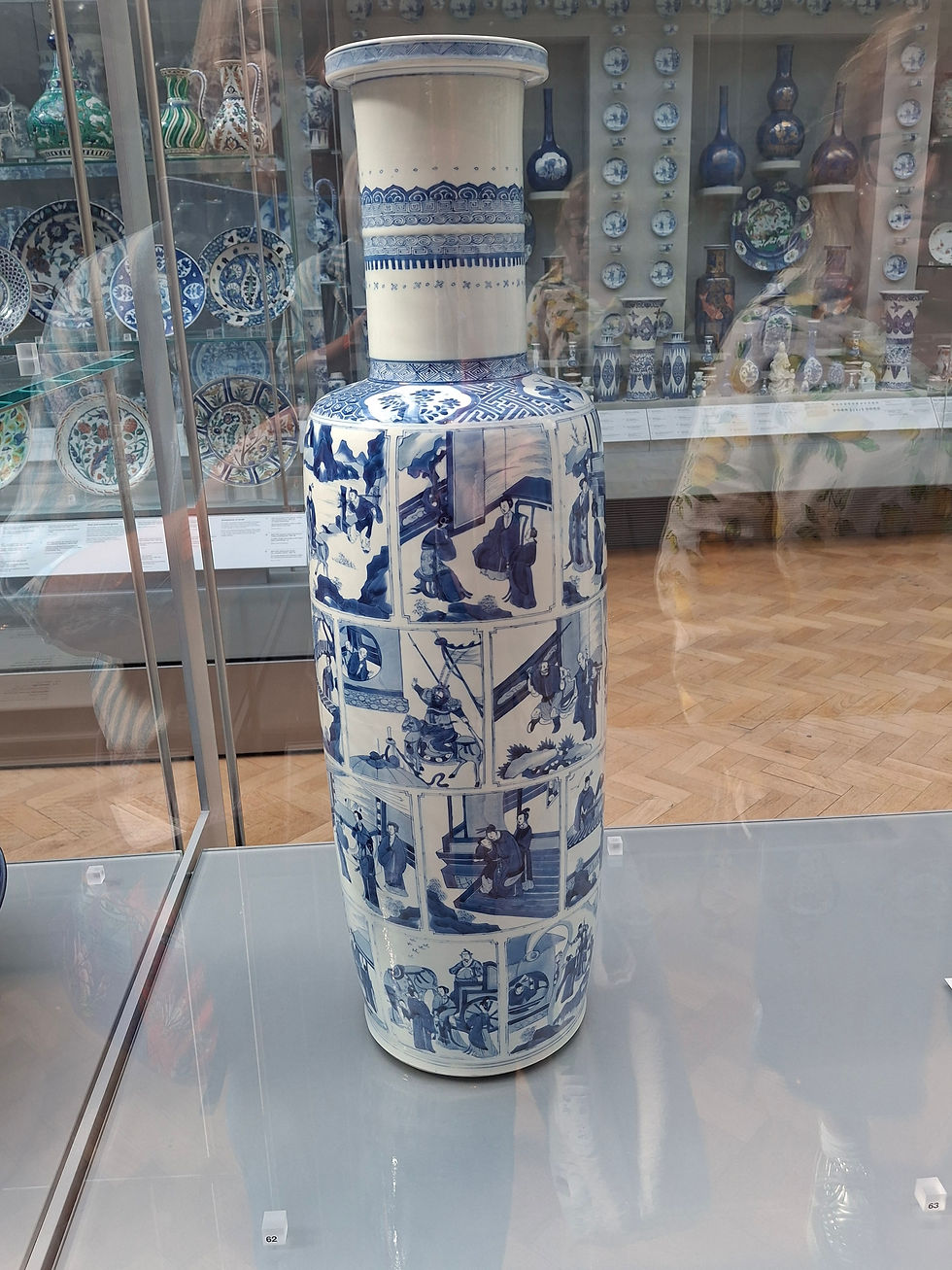
Camel, Sui dynasty ( 581-618 ). Glazed.

'Large ceramic horses were placed in tombs.... Earthenware, moulded in sections and assembled, details finished by hand, splashed with colour (sancai) lead glazes.'
n.b.
'The brown glaze running down the neck may relate to the "blood-sweating" horses imported from the Ferghana Valley,( now in Ubekistan ). This really happens and is a feature of the breed.
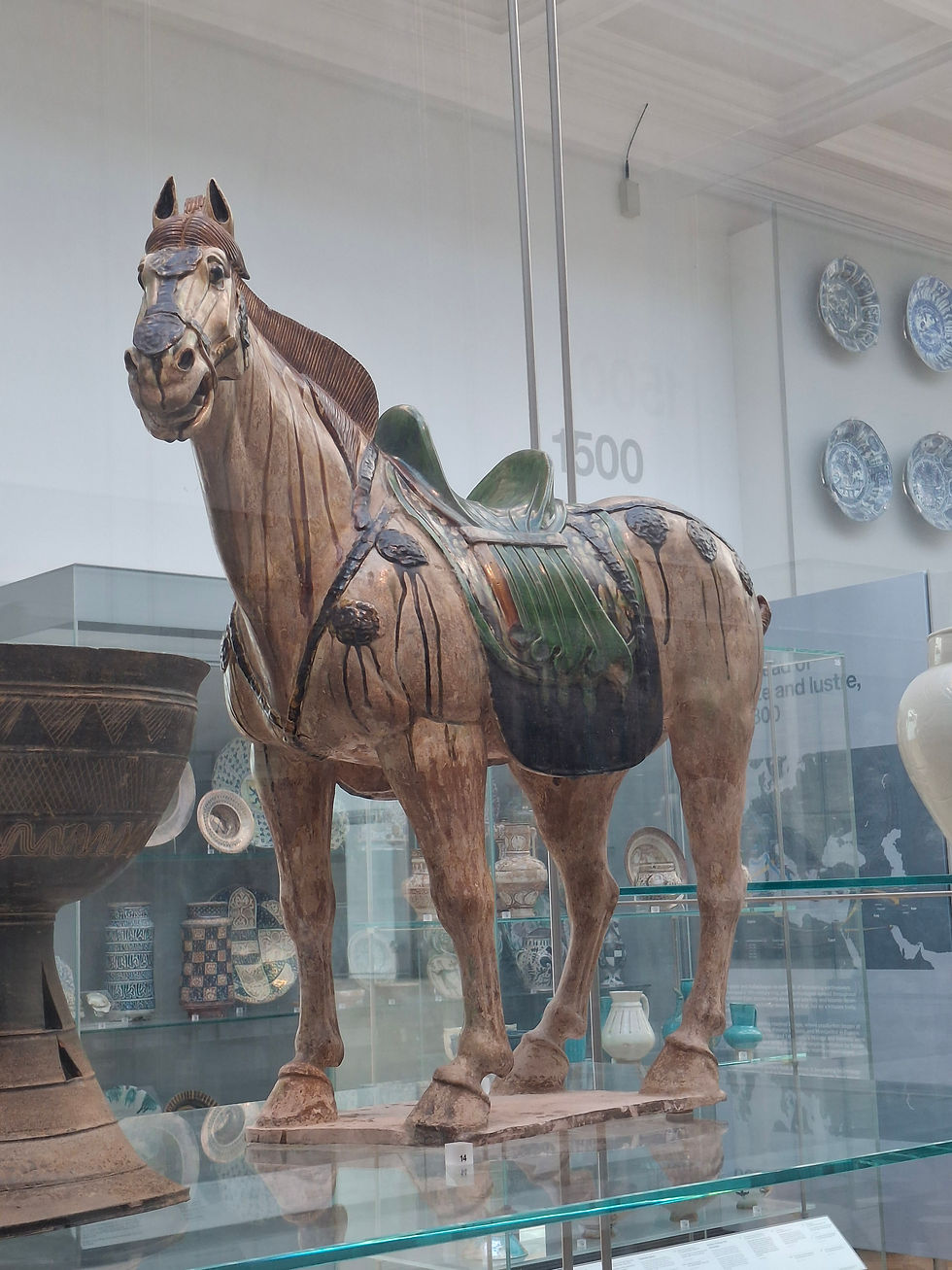
Some ancient lions holding up a pillar.
Literally true now. Wildlife survival is holding the key to continued human existence.

Incised Celedon bottle with lotus and waterbird. Korea, Koryo dynasty (1200 - 1300). I think the bird particularly is very beautiful in its simplicity. A naive drawing.

I have done some limited inlay with vitreous slip or engobe. It seems like a popular decorating process through the ages - more so than sgraffito.
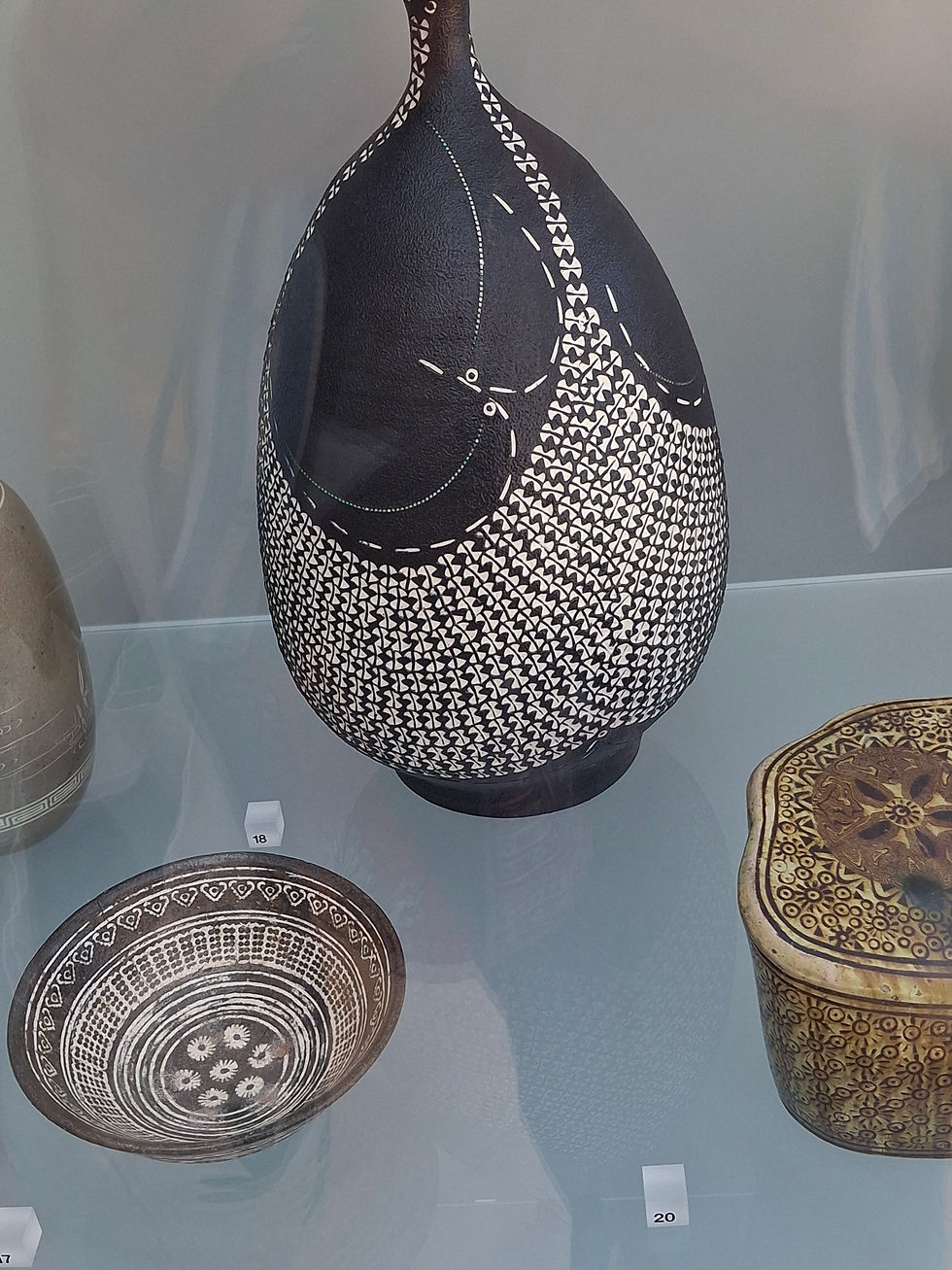
This interesting bottle is by Yutaka Kondo (1932 -83). The surface is stamped for texture with black slip over. After the first firing he inlaid white (engobe) slip into the stamped impressions and covered the piece with a thin glaze.
Inlay and sgraffito ( and carving ) are all related. They make a groove. Inlay is sgraffito with a contrasting slip 'inlayed' in the scratched grooves.
Carving is a bit more course on most vessels, and a deeper mark. An example is Halima Cassel, who has taken carving to the extreme, both in complicated patterns, scale and accuracy. I saw her exhibition at Blackwell in 2023.
This is something different... Made in London in 1978 by Martin Smith, this bowl is earthenware with geometrical pattern in white glaze.
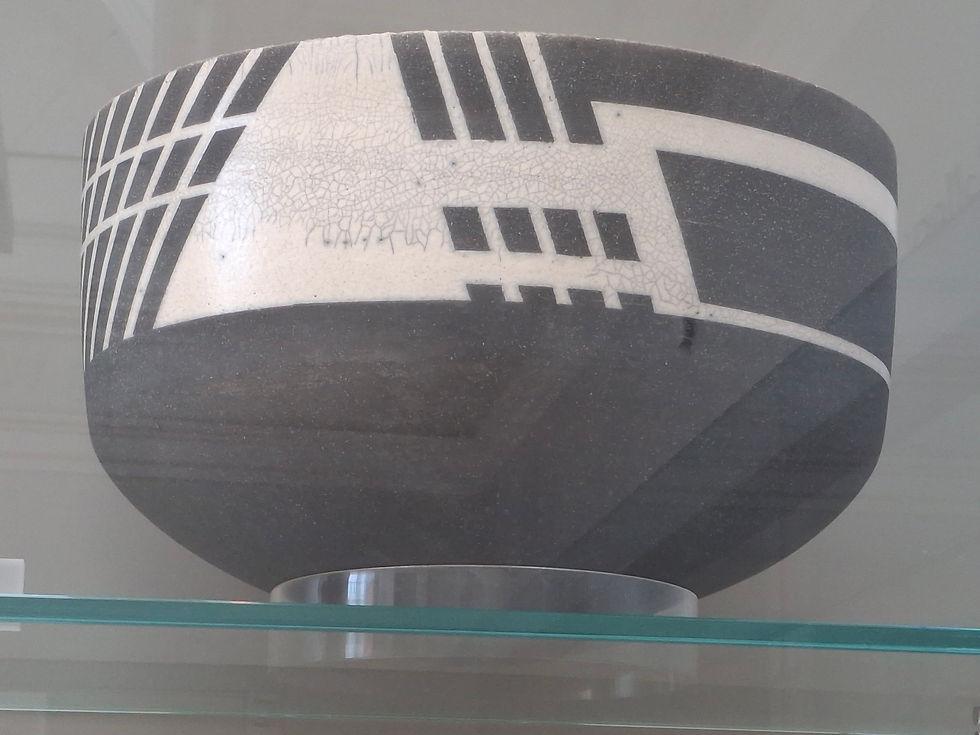
I talked to Julie Ayton at Ceramic Art London, who told me her technique was to scratch through the glaze before applying another glaze - sgraffito with glaze - not something I have done, or really heard of before. I guess ceramics has no limit of possibilities!
Now onto Contemporary Ceramics
"Little horror ", 1997, made by Susan Halls, raku fired paper clay, thrown in sections, altered and assembled with slip.
Susan is having a year in residency at Uclan. She has been invited to exhibit her work at the British Ceramics Bienniel in Stoke later this year. Her work for this is very complicated and large!

Bird with outstretched wings, Hans Coper (1920 - 81).
Perhaps a Phoenix.

The above was made in Lucie Rie's studio, London. The drawing is incised through brown pigment under a white glaze - again sgraffito with glaze. Exterior white slip over brown pigment.

Lucie Rie (1902 - 95), Bottle Vase . This was made in London, and is in stoneware with a white glaze with brown flecks.
This one is made in London by Steven Sykes (1914 - 99). It is earthenware with painted decoration and a white tin glaze.
It is aptly called 'Daphne' and was made in 1951. A lovely, slightly eccentric lady called Daphne looked after my horse. Punch. This piece fits my memory of her.
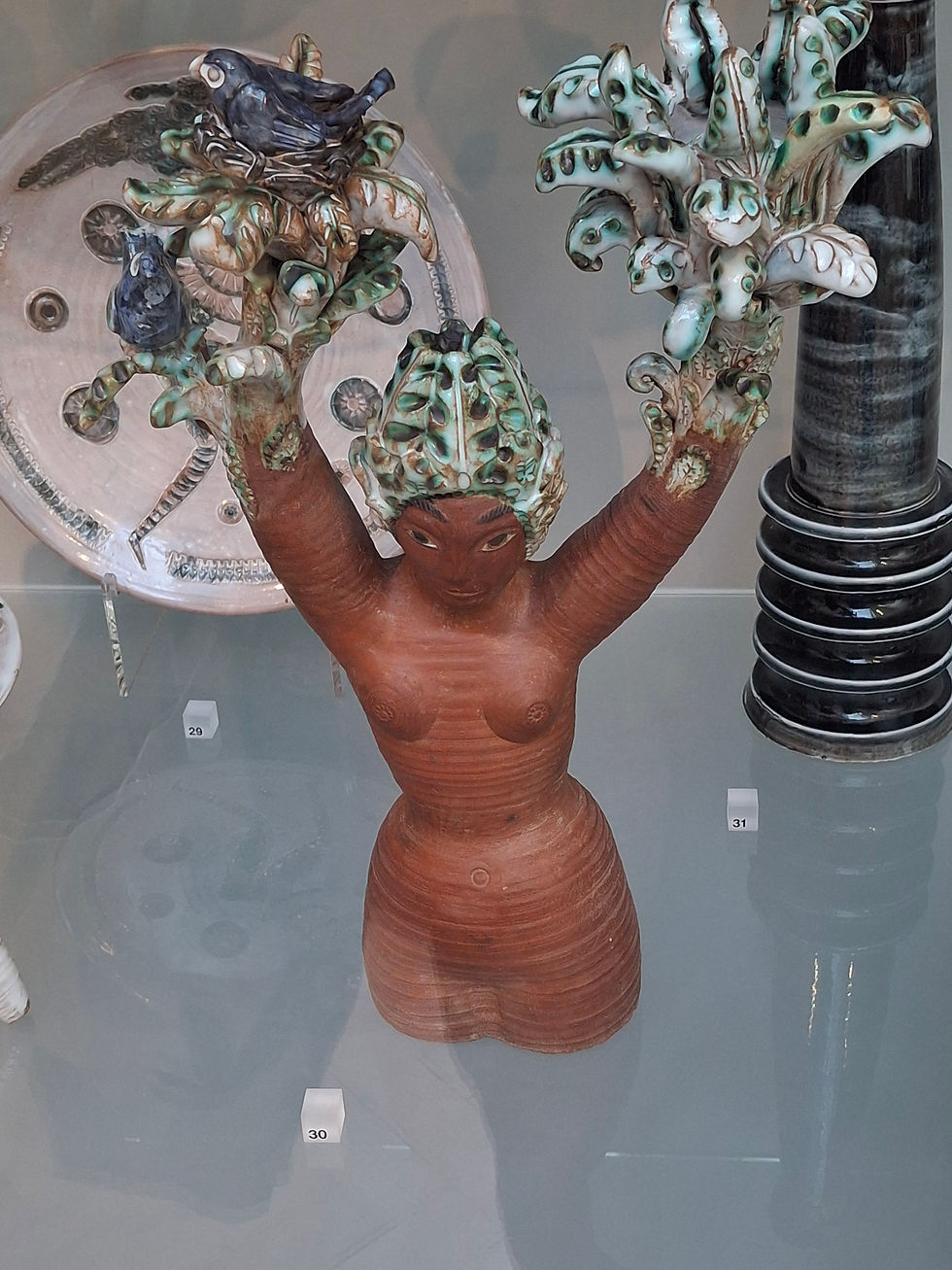
This piece is 'Tripod Bird', made in London in 1951 by Steven Sykes (1914 -99). It is tin glazed with painted decoration. I just liked this for its ingenuity and use of decorating technique; stamp and copper oxide.

This is a dish of a dashing grey horse. It is made by Odney Pottery in 1949 in Berkshire. It is decorated by A. F. Spindler and is earthenware with slip decoration. Slip trailing is another technique, along with sgraffito, used in slipware pottery. Again the traditional earthenware clay, though not a traditional glaze for slipware.

I like this piece, I think it is a rider on a horse. It looks like a pigment or enamel over a glaze...could be tin glaze with oxide drawing. Nice brush strokes.
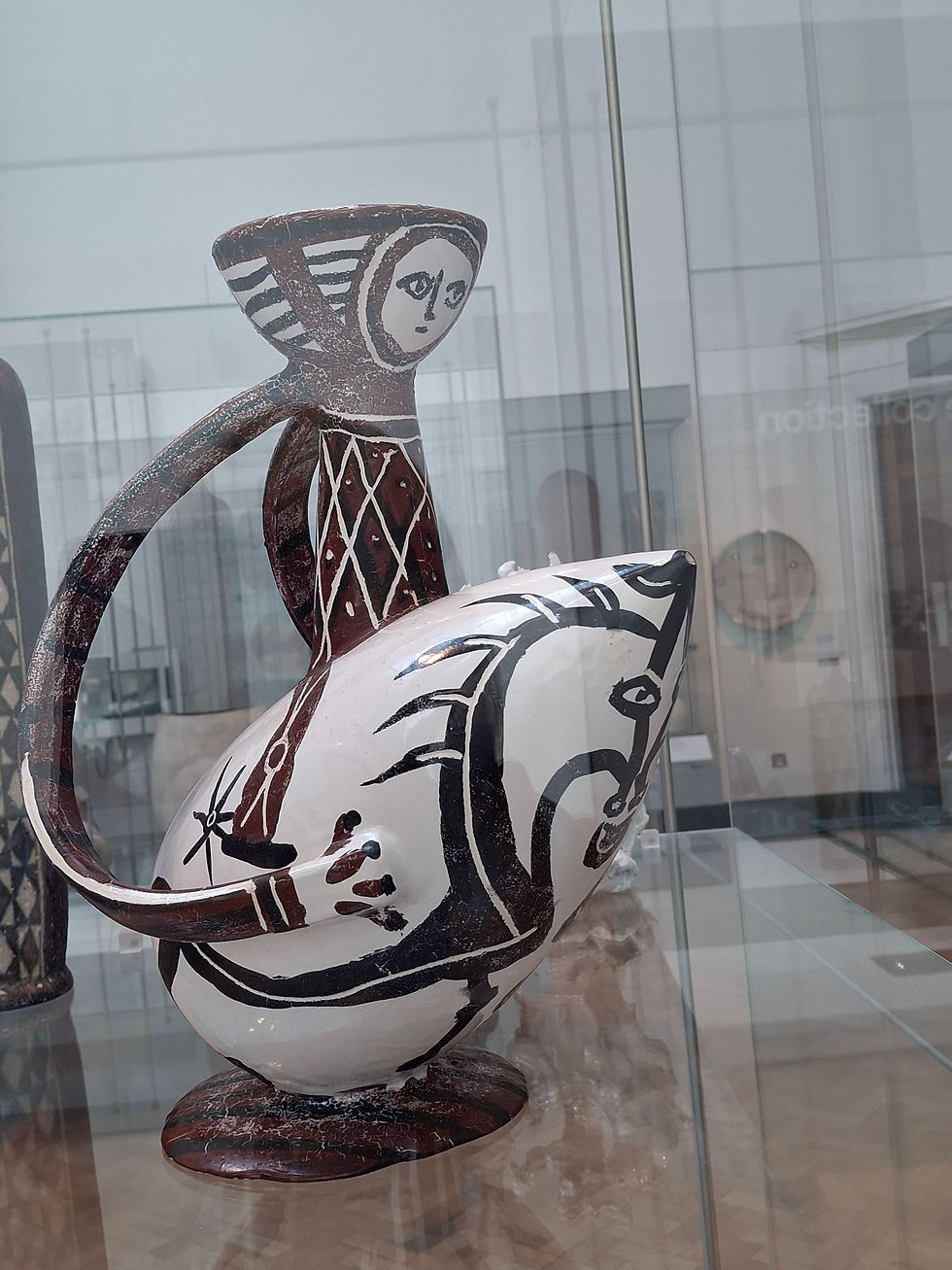
'Pair of Doves' by Margaret Hine (1927 - 87), in 1954. It is in earthenware with and interesting decoration. It uses incised decoration through a brown glaze over a white tin glaze.
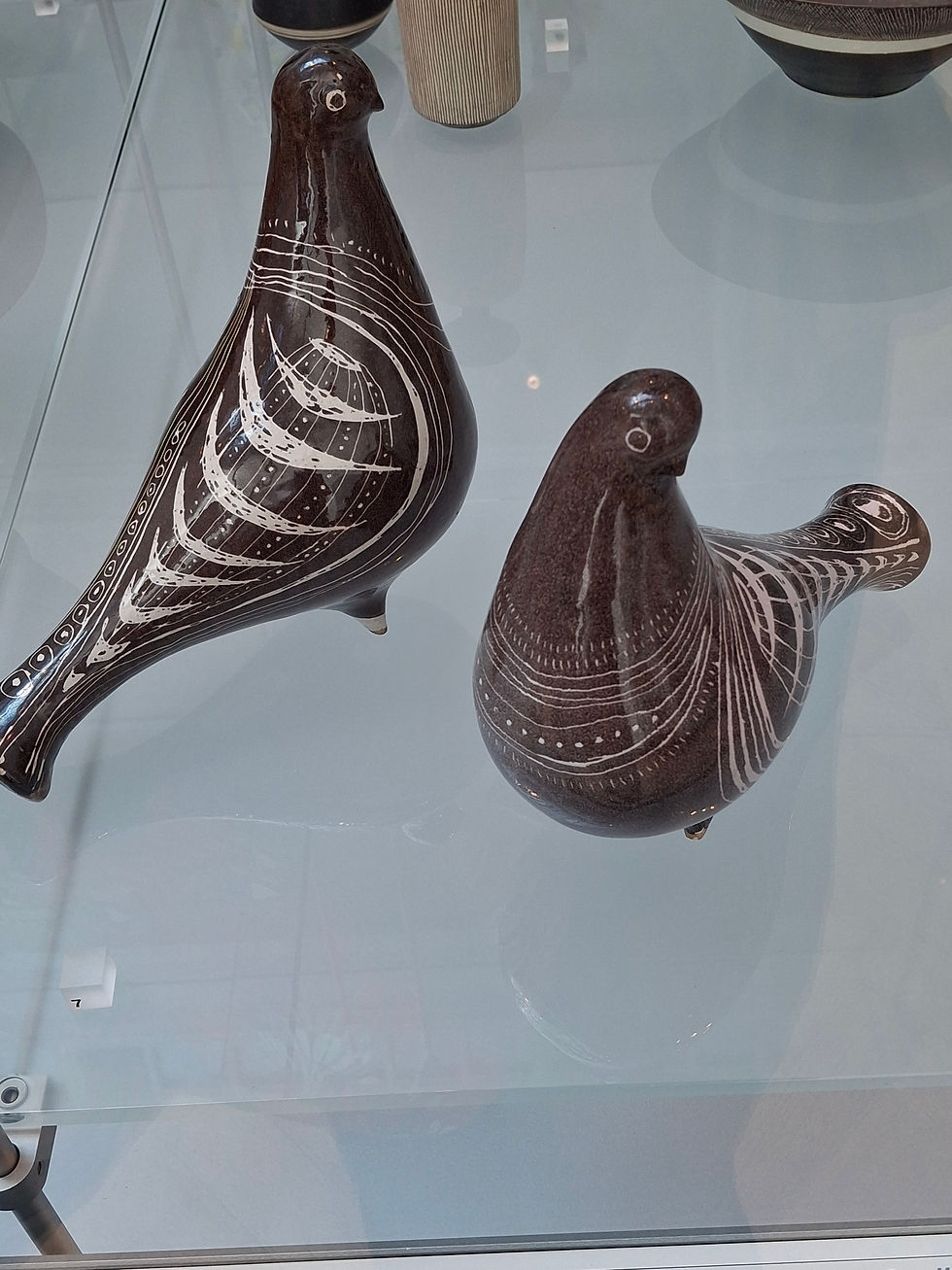
Vase by William Newlard 1957. It is coiled with carved decoration under a grey glaze.

Another carved vessel....
Vase 1924, earthenware and made in London. It is incised through green glaze. This time the incision is after the glaze has been applied. Made by Yoshikawa Masamidu (1946).

Blue Teapot and Mug, 1988. This was made in London, it is stoneware, handbuilt, inlaid, incised and painted.
I like the waywardness of this - I am beginning to enjoy surreal things, especially after visiting '40 years of Surreal Landscapes' at the Hepworth in March. This just shows that interesting effects can be made by combining decorating techniques.

'Boat, White Moon and Stars' 1990.
This is handbuilt white, matt blue and black glazes. I have experimented (Borneo dish) using black clay, blue slip and white matt glaze, creating a similar colour palate and not dissimilar effect on the finished piece.

"Two Ladies averting the angry Swallow", 1983 in Montana USA. It is stoneware, handbuilt with coloured glazes and incised decoration.
I like the slip decoration of this, it reminds me of Jitka Palmer, a Czech Ceramic Artist. I was quite influenced by her work after seeing her work and seeing a demo she did at the International Ceramics Festival, Aberystwyth in 2015. She does sgraffito on both red and white earthenware clay. She does the human form (mainly faces) unlike myself who prefers the animal form. I like her style and free way of working, conveying a lot of movement. Her vessels are handbuilt and the tops slightly undulating. I like this, and have borrowed it from her in some of my hand coiled vessels.
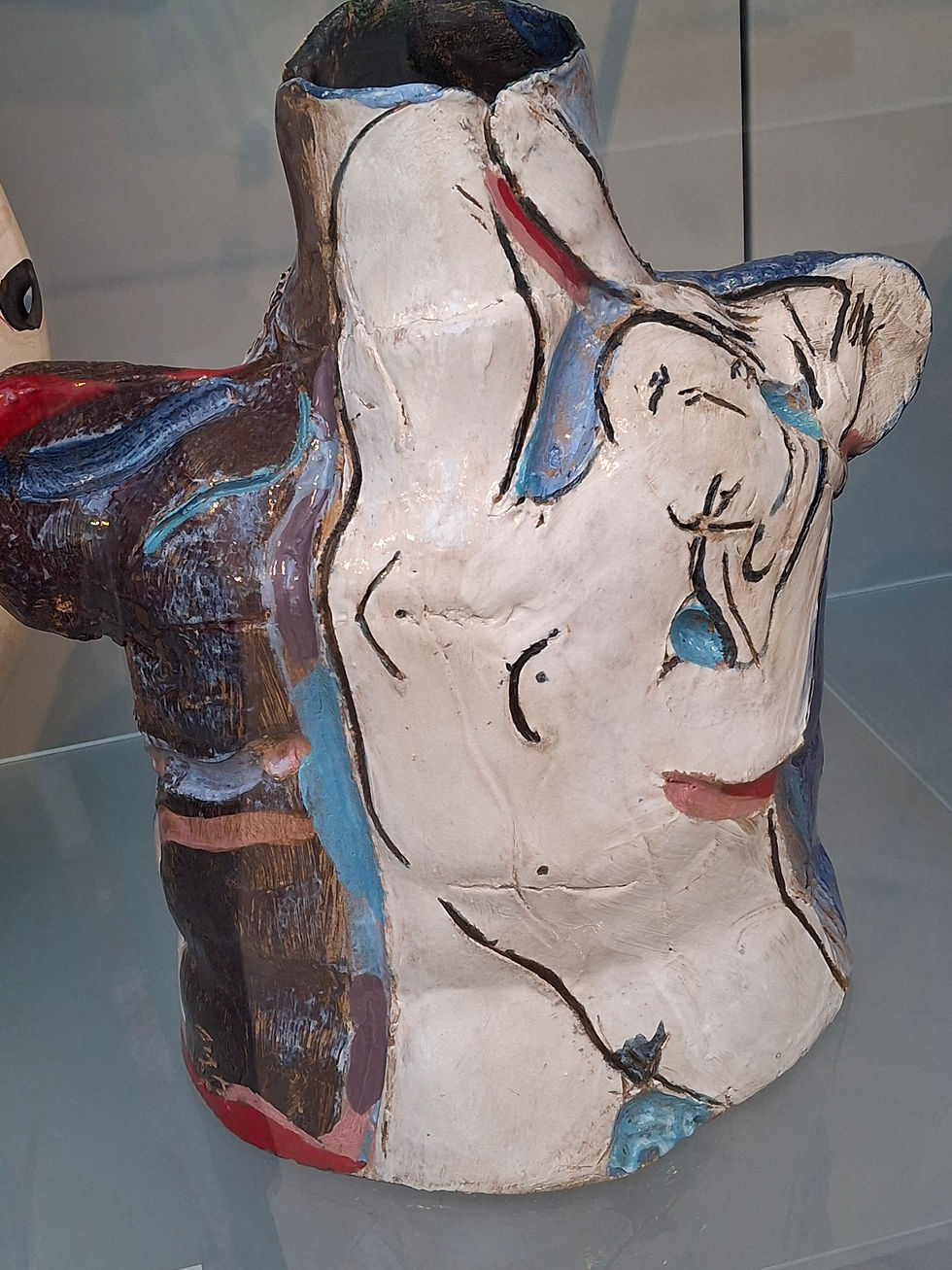
Animal Head,1992 by Sin Sang-Ho ( born 1936). He is Korean, and has made a reference to Korea's rich ceramic heritage by using a slip decoration called punch'ong, developed during the 15th and 16th centuries. It is stamped, incised and slip filled. I like the effect and the mixing up of techniques!
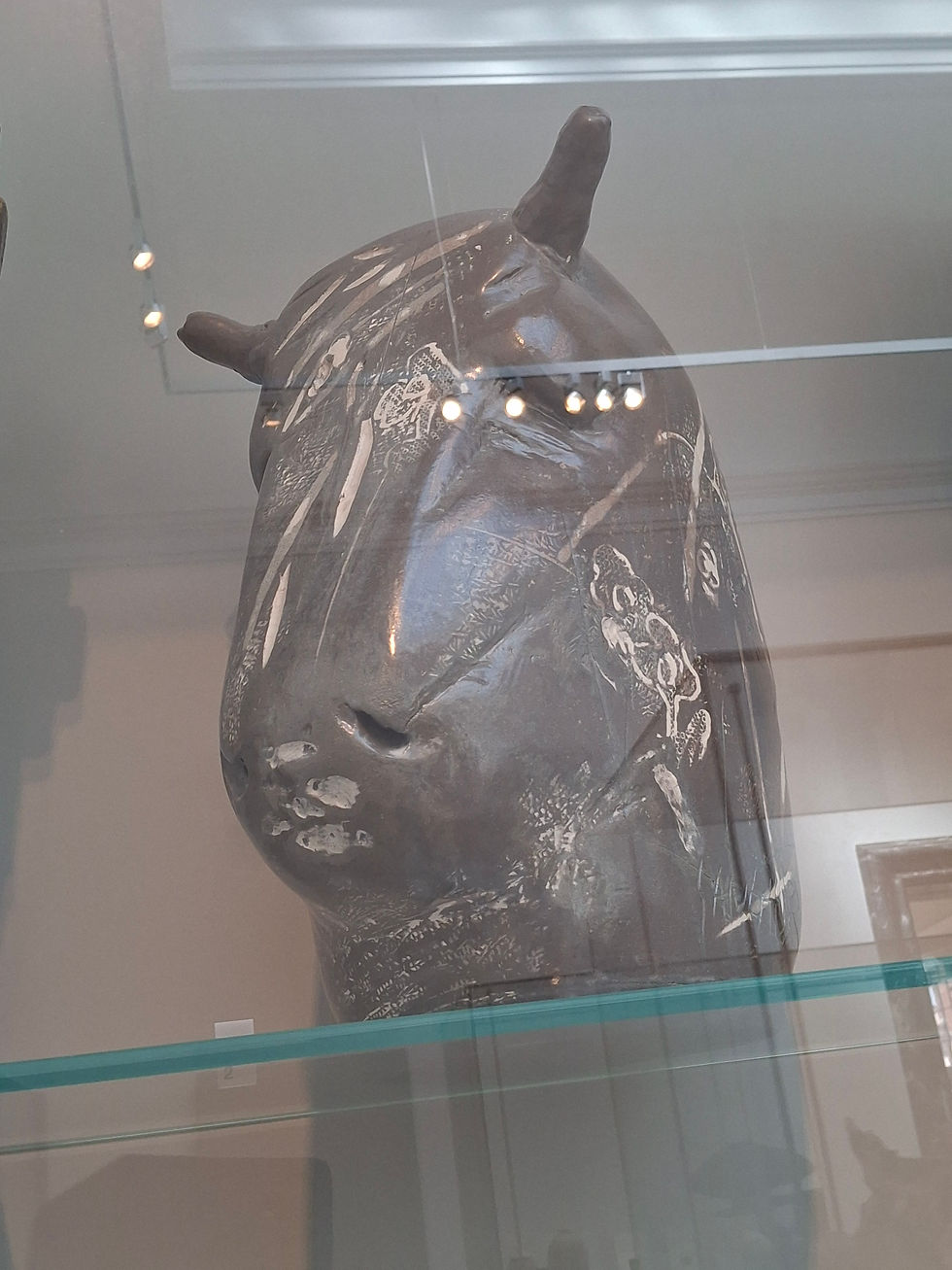
'Mother and Child' by Phillip Elgin ( born 1959). He is influenced by Staffordshire figurines. This has references both to the Virgin Mary and baby Jesus, and Venus and Cupid. Confrontational and thought provoking.

Vase by Grayson Perry (born 1960).
I think this vase uses slips and sgraffito. The label said 'incised decoration', but I think it looks more like painted slip and sgraffito.
It depicts Barry Sheene, motorcylist; punk singer, Mark Esmuth; transexual model, April Ashley and 19th century artist Aubrey Beardsley. These people are likely to be his icons. He " assigns them the status of popular heroes in an imagined folk-art tradition."
"If it is not there in history - make your own".


Felicity Aylieff (born 1954)

I believe she now has her work made in China. You can see the oriental influence, with a twist. She uses over glaze enamels .
She works regularly in Jindezen, known as the centre for porcelain production. She works with highly skilled local potters.
My friend, Sarah, who came with me to the V&A had just visited an exhibition by her which featured massive oversize vases. There was one on display at the V&A. I think that exhibition is also visiting the Hepworth.
Lastly, but certainly not least, was work by Vicky Lindo, including work from her exhibition 'Dead Dad Book'. This has been well documented, but in brief it is a tribute to her late father, who came over as the Windrush generation, and died in a wood in sad circumstances.
I will just add photos from the V&A's Collection by Vicky Lindo. One of my earlier blogs is about Vicky Lindo's practice. To me she signifies a lot of what sgraffito is about. Again she has human issues as a subject but she is confrontational. I like her approach to the subject and the exquisite execution of her craft skills, being also a bit quirky, which I think is how sgraffito distorts the subject matter, I find!
A great end to the best part of a week in London! Thank you Ruth, and Sarah and family for your wonderful company. The cab rides were a great way to see London too.





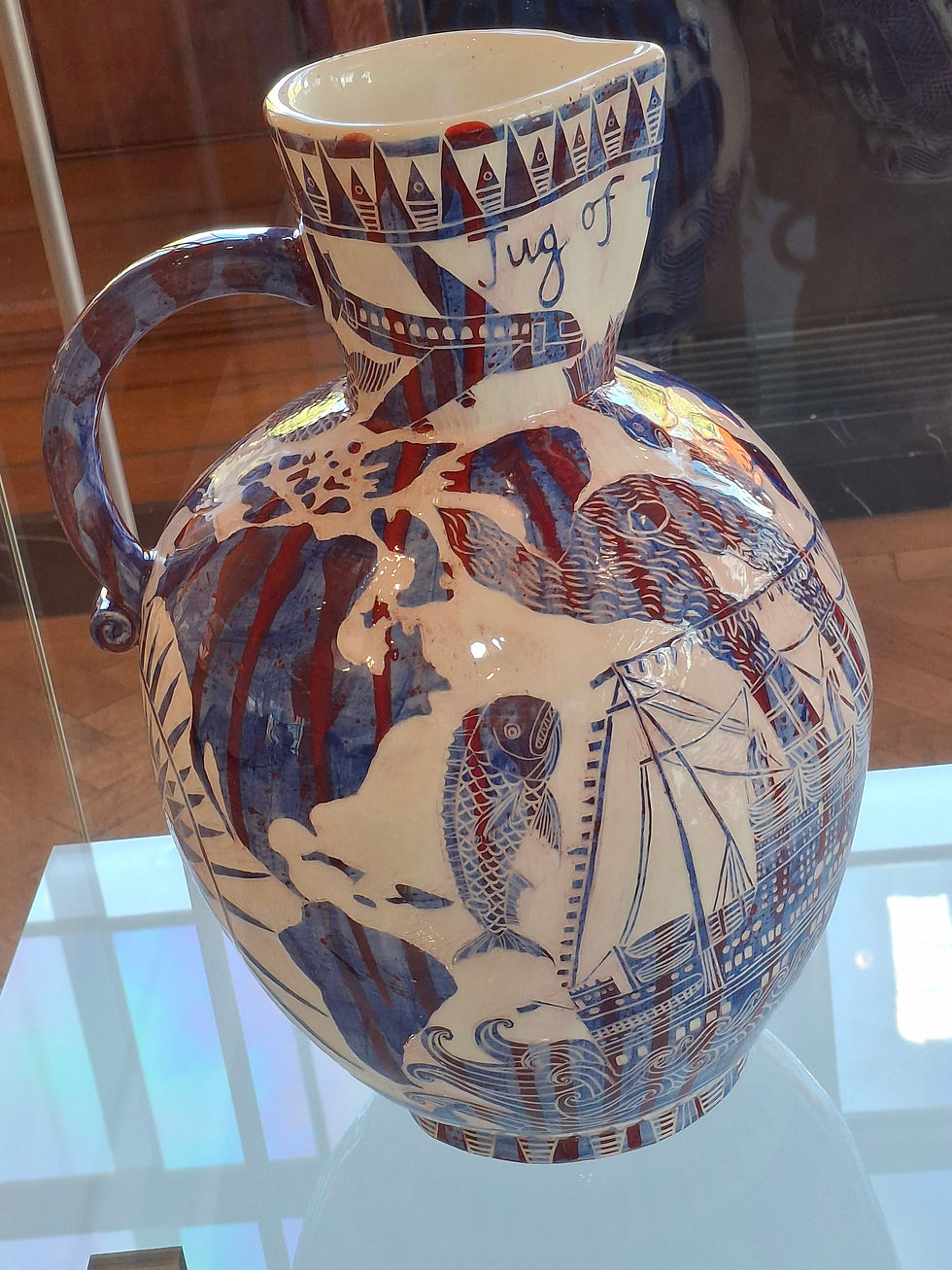
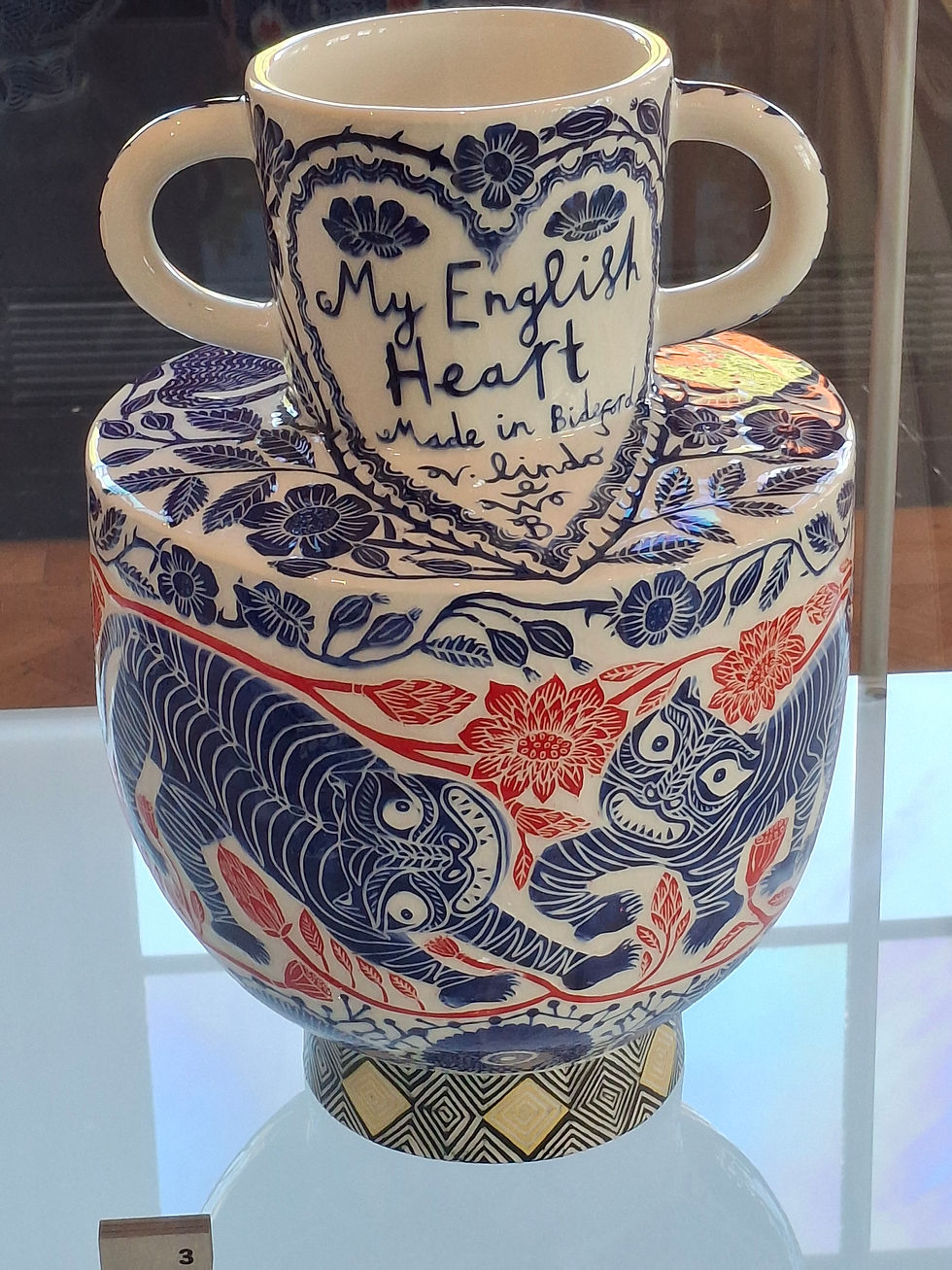









Comments